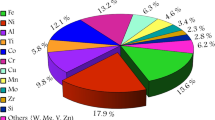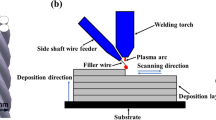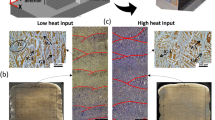Abstract
The φ16 mm single-crystal copper rod billet was prepared by the heated mold horizontal continuous casting process. After cold drawing + 600 °C× 5 s annealing to φ1 mm, the annealed φ1 mm single-crystal copper processing wire was cold drawn to φ0.2 mm (φ1 mm → φ0.2 mm), and the electrical conductivity, tensile strength and microstructure evolution of single-crystal copper wire were compared and analyzed. The research shows that the conductivity of the as-cast single-crystal copper rod is 102.1% IACS, the tensile strength is 141 MPa, the conductivity is as high as 97.26% IACS, after cold drawing to φ0.2 mm, and the tensile strength is greatly increased to 506 MPa. Compared with the as-cast properties, the electrical conductivity of the as-drawn wire is only reduced by 4.7%, while the tensile strength is increased by 258.9%. The as-cast rod exhibits typical characteristics of single-crystal copper; with the increasing amount of deformation, the microstructure evolves in the following form: dislocations generated by slip entanglement into dislocation cells → microstrip structure → layered structure → twin structure. A prediction model for the strength and electrical conductivity of single-crystal copper wire was constructed. The results show that grain refinement strengthening and dislocation strengthening are the key factors affecting the strength and conductivity of single-crystal copper wire, when deformed to φ0.2 mm, and twinning strengthening is superimposed in the above strengthening mechanism.









Similar content being viewed by others
Data availability
The data that support the findings of this study are available from the corresponding author upon reasonable request.
References
Gamin YV, Alberto J (2021) Influence of the radial-shear rolling (RSR) process on the microstructure, electrical conductivity and mechanical properties of a Cu-Ni-Cr-Si alloy. Mater Sci Eng A 822:141676. https://doi.org/10.1016/j.msea.2021.141676
Li R, Zhang S, Zou C, Kang H, Wang T (2019) The roles of Hf element in optimizing strength, ductility and electrical conductivity of copper alloys. Mater Sci Eng A 758:130–138. https://doi.org/10.1016/j.msea.2019.04.110
Hu PH, Song HWU, Wang SW, Chen Y, Zhang SH (2021) Mechanisms of primary phase refinement and toughness improvement of Cu-2 wt% Ag-0.15 wt% La alloy through continuous extrusion forming. Mater Sci Eng A 819:141521. https://doi.org/10.1016/j.msea.2021.141521
Zhang M, Liu L, Liang S, Li J (2020) Evolution in microstructures and mechanical properties of pure copper subjected to severe plastic deformation. Met Mater Int 26:1585–1595. https://doi.org/10.1007/s12540-019-00395-z
Park H, Kim SH, Lee WJ, Ha JW, Kim SJ, Lee HJ (2020) Effect of wire-drawing process conditions on secondary recrystallization behavior during annealing in high-purity copper wires. Met Mater Int 27:2220–2229. https://doi.org/10.1007/s12540-020-00682-0
Zhang LG, Song QM, Xu XW, Xu ZM (2021) Process simulation of Ohno continuous casting for single crystal copper prepared from scrap copper in waste printed circuit boards. Waste Manag 124:99–101. https://doi.org/10.1016/J.WASMAN.2021.01.036
Jiang Y, Zhang T, Lei Y, Liu X (2020) Microstructure evolution and mechanical properties of Cu-03.6Be-04.6Co alloy fabricated by heating − cooling combined mold horizontal continuous casting during cold rolling. Trans Nonferrous Met Soc China 30:958–971. https://doi.org/10.1016/S1003-6326(20)65268-2
Ban Y, Geng Y, Hou J, Zhang Y, Zhou M (2021) Properties and precipitates of the high strength and electrical conductivity Cu-Ni-Co-Si-Cr alloy. J Mater Res Technol 93:1–6. https://doi.org/10.1016/j.jmst.2021.03.049
Ma XG, Chen J, Chen Z, Yan W (2015) Evolution of microstructure and texture of cold-drawn polycrystalline Ag with low stacking fault energy. Sci China Technol Sci 58:1146–1153. https://doi.org/10.1007/s11431-015-5862-8
Gao K, Liu M, Zou F, Pang X, Xie J (2010) Characterization of microstructure evolution after severe plastic deformation of pure copper with continuous columnar crystals. Mater Sci Eng A 527:4750–4757. https://doi.org/10.1016/j.msea.2010.04.019
Luo XM, Song ZM, Li ML, Wang Q, Zhang GP (2017) Microstructural evolution and service performance of cold-drawn pure aluminum conductor wires. J Mater Sci Technol 33:1039–1043. https://doi.org/10.1016/j.jmst.2016.11.018
Guo N, Li D, Yu H, Xin R, Zhang Z, Li X, Liu C, Song B, Chai L (2017) Annealing behavior of gradient structured copper and its effect on mechanical properties. Mater Sci Eng A 702:331–342. https://doi.org/10.1016/j.msea.2017.07.023
Yoshida Y, Miyajima S (2012) Onaka, changes in strength and microstructure of Cu (100) [001] single crystals caused by accumulative roll-bonding. Mater Trans 53:26–29. https://doi.org/10.2320/matertrans.MD201116
Yang F, Dong L, Cai L, Wang L, Xie Z, Fang F (2021) Effect of cold drawing strain on the microstructure, mechanical properties and electrical conductivity of low-oxygen copper wires. Mater Sci Eng A 818:141348. https://doi.org/10.1016/j.msea.2021.141348
Suresh KS, Sinha S, Chaudhary A, Suwas S (2012) Development of microstructure and texture in copper during warm accumulative roll bonding. Mater Charact 70:74–82. https://doi.org/10.1016/j.matchar.2012.04.017
Kauffmann A, Freudenberger J, Geissler D, Yin S, Schillinger W, Subramanya Sarma V, Bahmanpour H, Scattergood R, Khoshkhoo MS, Wendrock H, Koch CC, Eckert J, Schultz L (2011) Severe deformation twinning in pure copper by cryogenic wire drawing. Acta Mater 59:7816–7823. https://doi.org/10.1016/j.actamat.2011.08.042
Sun PF, Zhang PL, Hou JP, Wang Q, Zhang ZF (2021) Quantitative mechanisms behind the synchronous increase of strength and electrical conductivity of cold-drawing oxygen-free Cu wires. J Alloys Compd 863:158759. https://doi.org/10.1016/j.jallcom.2021.158759
Wagoner RH, Shen ZY, Lee TC, Robertson IM, Birnbaum HK (1992) On the criteria for slip transmission across interfaces in polycrystals. Scr metall Mater 26:203–206. https://doi.org/10.1016/0956-716X(92)90173-C
Hall EO (1951) The deformation and ageing of mild steel: III discussion of results. Proc Phys Soc B 64:747–753. https://doi.org/10.1088/0370-1301/64/9/303
Dasharath SM, Koch C, Mula S (2015) Effect of stacking fault energy on mechanical properties and strengthening mechanisms of brasses processed by cryorolling. Mater Charact 110:14–24. https://doi.org/10.1016/j.matchar.2015.10.006
Grum J (2009) Book review: mechanical behavior of materials by M.A. Meyers and K.K. Chawla. Int J Microstruct Mater Prop. https://doi.org/10.1016/S1369-7021(09)70086-0
Cordero ZC, Knight BE, Schuh CA (2016) Six decades of the hall-petch effect—a survey of grain-size strengthening studies on pure metals. Int Mater Rev 61(8):495–512. https://doi.org/10.1080/09506608.2016.1191808
Kumar N, Mishra RS (2013) Additivity of strengthening mechanisms in ultra fi ne grained Al-Mg-Sc alloy. Mater Sci Eng A 580:175–183. https://doi.org/10.1016/j.msea.2013.05.006
Zhang ZF, Wang ZG (1998) Effects of grain boundaries on cyclic deformation behavior of copper bicrystals and columnar crystals. Acta Mater 46:5063–5072. https://doi.org/10.1016/S1359-6454(98)00162-1
Rodríguez-calvillo P, Ferrer N, Cabrera JM (2015) Analysis of microstructure and strengthening in CuMg alloys deformed by equal channel angular pressing. J Alloys Compd 626:340–348. https://doi.org/10.1016/j.jallcom.2014.12.043
Williamson GK, Smallman RE (1956) III Dislocation densities in some annealed and cold-worked metals from measurements on the X-ray debye-scherrer spectrum. Philos Mag 1:34–46. https://doi.org/10.1080/14786435608238074
Parthiban R, Ray RK, Hari kumar KC, Sankaran S (2021) Influence of rolling temperature and strain on the microstructural evolution and mechanical properties in quench and partition (Q&P) steels. Mater Sci Eng A 825:141893. https://doi.org/10.1016/j.msea.2021.141893
Miyajima Y, Okubo S, Abe H, Okumura H, Fujii T, Onaka S, Kato M (2015) Materials characterization dislocation density of pure copper processed by accumulative roll bonding and equal-channel angular pressing. Mater Charact 104:101–106. https://doi.org/10.1016/j.matchar.2015.04.009
Jiang Y, Li D, Zhang X, Zou J, Xiao P, Liang S (2018) Effects of various strengthening methods on the properties of Cu–Ti–B alloys. Mater Sci Technol 34:340–346. https://doi.org/10.1080/02670836.2017.1390645
Zeng W, Xie JW, Zhou DS, Fu ZQ, Zhang DL (2018) Bulk Cu-NbC nanocomposites with high strength and high electrical conductivity. J Alloys Compd 745:55–62. https://doi.org/10.1016/j.jallcom.2018.02.215
Basinski ZS, Dugdale JS, Howie A (1963) The electrical resistivity of dislocations. Philos Mag 8:1989–1997. https://doi.org/10.1080/14786436308209092
Mao Q, Zhang Y, Guo Y, Zhao Y (2021) Enhanced electrical conductivity and mechanical properties in thermally stable fine-grained copper wire. Commun Mater 2:1–9. https://doi.org/10.1038/s43246-021-00150-1
Botcharova E, Freudenberger J, Schultz L (2006) Mechanical and electrical properties of mechanically alloyed nanocrystalline Cu-Nb alloys. Acta Mater 54:3333–3341. https://doi.org/10.1016/j.actamat.2006.03.021
Murashkin MY, Sabirov I, Sauvage X, Valiev RZ (2016) Nanostructured Al and Cu alloys with superior strength and electrical conductivity. J Mater Sci 51:33–49. https://doi.org/10.1007/s10853-015-9354-9
Acknowledgements
Thanks to Dr. Qianqian Zhu, Dr. Xiaowen Peng, Dr. Yunxiao Hua, etc. for their help in data processing, and thanks to the Electron Microscopy Center of Henan University of Science and Technology for their technical support.
Funding
This work was supported by the National Natural Science Foundation of China (U21A2051, 52173297, 52071133), R & D Projects of Henan Academy of Sciences (220910009), Key R&D and Promotion Projects of Henan Province (212102210441) and Zhongyuan scholar workstation funded project (214400510028).
Author information
Authors and Affiliations
Contributions
XL was responsible for methodology, formal analysis, writing the original draft and visualization. YZ was involved in writing, reviewing and editing, project administration, supervision and funding acquisition. YL took part in conceptualization, writing, reviewing and editing, visualization and data curation. SL contributed to writing, reviewing and funding acquisition. KS participated in writing, reviewing and editing, and funding acquisition. CF was involved in investigation and resources. BW was responsible for resources. PZ carried out investigation and visualization. HW and JG contributed to software. SH and YG took part in visualization.
Corresponding authors
Ethics declarations
Competing of interest
The authors declare that they have no known competing financial interests or personal relationships that could have appeared to influence the work reported in this paper.
Additional information
Handling Editor: Naiqin Zhao.
Publisher's Note
Springer Nature remains neutral with regard to jurisdictional claims in published maps and institutional affiliations.
Rights and permissions
Springer Nature or its licensor (e.g. a society or other partner) holds exclusive rights to this article under a publishing agreement with the author(s) or other rightsholder(s); author self-archiving of the accepted manuscript version of this article is solely governed by the terms of such publishing agreement and applicable law.
About this article
Cite this article
Li, X., Zhou, Y., Liu, Y. et al. Microstructure evolution of high-strength and ultra-high-conductivity microfilament wire prepared by continuous deformation of single-crystal copper. J Mater Sci 57, 20895–20908 (2022). https://doi.org/10.1007/s10853-022-07919-w
Received:
Accepted:
Published:
Issue Date:
DOI: https://doi.org/10.1007/s10853-022-07919-w




